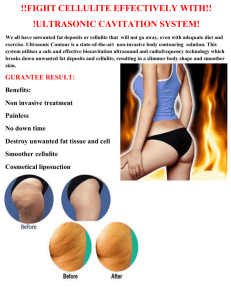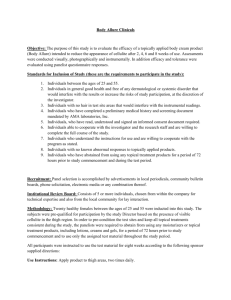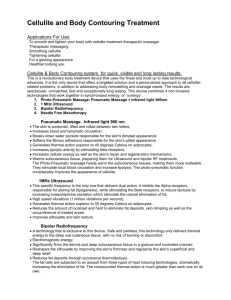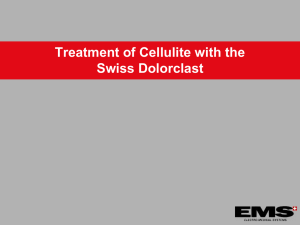Chapter 3 Pathophysiology of Cellulite
advertisement
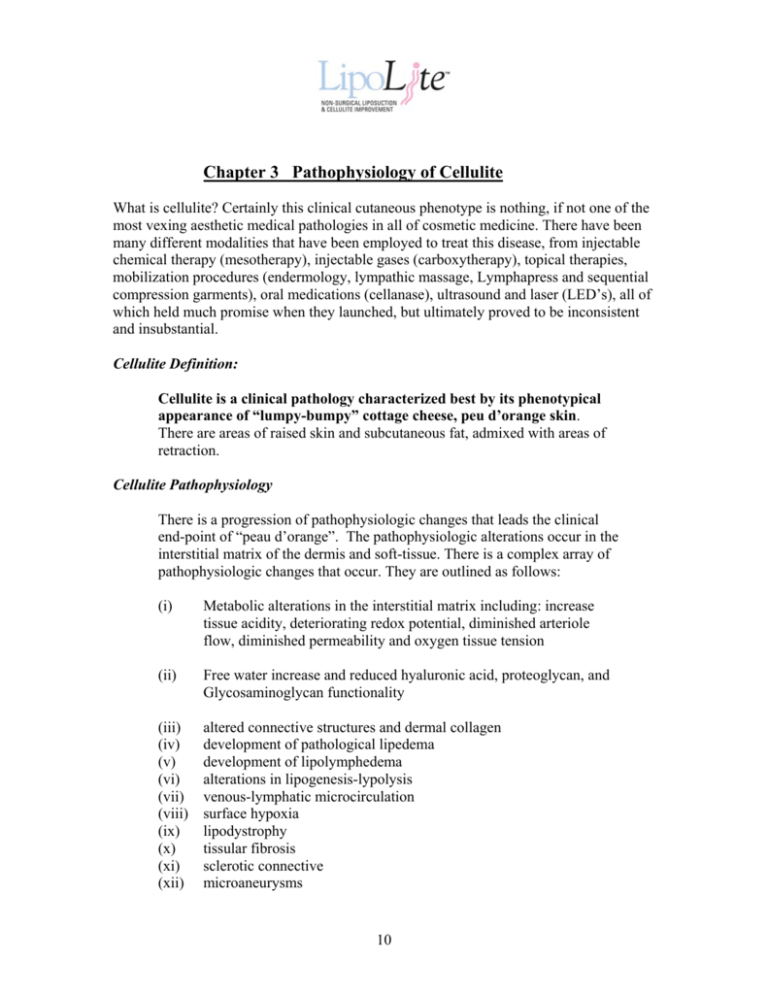
Chapter 3 Pathophysiology of Cellulite What is cellulite? Certainly this clinical cutaneous phenotype is nothing, if not one of the most vexing aesthetic medical pathologies in all of cosmetic medicine. There have been many different modalities that have been employed to treat this disease, from injectable chemical therapy (mesotherapy), injectable gases (carboxytherapy), topical therapies, mobilization procedures (endermology, lympathic massage, Lymphapress and sequential compression garments), oral medications (cellanase), ultrasound and laser (LED’s), all of which held much promise when they launched, but ultimately proved to be inconsistent and insubstantial. Cellulite Definition: Cellulite is a clinical pathology characterized best by its phenotypical appearance of “lumpy-bumpy” cottage cheese, peu d’orange skin. There are areas of raised skin and subcutaneous fat, admixed with areas of retraction. Cellulite Pathophysiology There is a progression of pathophysiologic changes that leads the clinical end-point of “peau d’orange”. The pathophysiologic alterations occur in the interstitial matrix of the dermis and soft-tissue. There is a complex array of pathophysiologic changes that occur. They are outlined as follows: (i) Metabolic alterations in the interstitial matrix including: increase tissue acidity, deteriorating redox potential, diminished arteriole flow, diminished permeability and oxygen tissue tension (ii) Free water increase and reduced hyaluronic acid, proteoglycan, and Glycosaminoglycan functionality (iii) (iv) (v) (vi) (vii) (viii) (ix) (x) (xi) (xii) altered connective structures and dermal collagen development of pathological lipedema development of lipolymphedema alterations in lipogenesis-lypolysis venous-lymphatic microcirculation surface hypoxia lipodystrophy tissular fibrosis sclerotic connective microaneurysms 10 (xiii) (xiv) (xv) (xvi) (xvii) (xviii) lipedema changes in venous capillary permeability decrease in the amount of GAG in vascular sleeves chronic tissue hypoxia adipose lobular edema fibrinoid and fibrous retratctions Clinical Presentation Cellulite most commonly affects the back, side and/or front of the thighs, and buttocks. The following alterations may be found: Diminished sensitivity Pain, cramps Heaviness Nocturnal restlessness Cold Feet Changes in skin coloration Livedo reticularis Dry Skin Ecchymosis Edema Clinical Classification 1. 2. 3. 4. 5. 6. 7. Adipose cellulite Edematous cellulite Adipoedematous cellulite Edematoadipose cellulite Fibrous cellulite Sclerotic cellulite Mixed cellulite 11 Investigations Most treatments are instituted based on clinical diagnosis alone, but others advocate: Doppler Laser Doppler Echo Doppler Thermography Vega STT Test Videocapilloscopy Treatment Diet Molecular therapy Colonotherapy Subdermal therapy VelaSmooth™ Mesotherapy Caroboxytherapy Pathophysiology of LipoLite™ Cellulite treatments: VelaSmooth™ delivers radiofrequency (RF) heat 2.5 cm into the fat and 0.5cm of Infrared (IR) heat into the dermis and fat. Through the thermogenic influences of the RF and IR there is a vasodilation, increased blood flow and increased tissue oxygenation. This leads to decongestion, improved venous and capillary blood flow and decreased lobular fat congestion. The mesotherapy, depending upon the “cocktail” leads to vasodilation, lipolysis, lobular decongestion and clinical smoothening. Carboxytherapy, again leads to vasodilation, increased blood flow, oxygenation and improvement in the clinical appearance of cellulite. . 12
